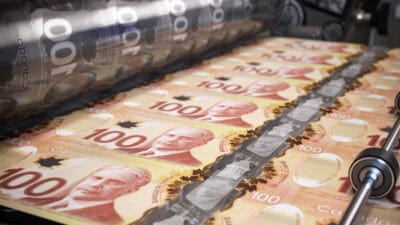Last week, the federal government released its fiscal snapshot for 2020. It wasn’t pretty. Forecasting a $343 billion deficit, it projected that federal debt would hit $1.2 trillion by the end of the year. $1.2 trillion is about $31,000 for every Canadian — including children and retirees. That’s a significant amount of debt per capita, and about $9,000 comes from the projected 2020 deficit alone.
So far, this news hasn’t had any negative impacts for investors. Stocks actually rallied on Friday when it broke. Still, there is one potential risk factor that investors have to be aware of in light of this. This has nothing to do with stock prices in and of themselves; rather, it has everything to do with the returns you actually take home. It’s a risk you face at all times, but it’s become all the more likely to materialize in light of Canada’s growing debt.
So, what is this risk factor, and what can you do about it?
Tax increases
In light of Canada’s growing debt, it would be unreasonable not to expect tax increases in the future. While it’s not always politically popular to raise taxes, a big enough debt increase can make it necessary.
Every extra dollar of debt adds a certain amount of annual interest. The higher a country’s interest expense, the more of its tax revenues go to paying it. That’s money that’s not going to pay for services — or, more accurately, money that’s paying for services consumed in the past. To keep the same level of services with rising debt, you need to either raise taxes or have the tax base increase. GDP growth can increase the tax base, but GDP has been declining this year. So, it seems likely that tax increases are coming.
How to keep your portfolio safe
When it comes to your employment income, you’ll largely have to take tax increases on the chin. You may be able to claim more tax deductions and credits than you’re now claiming — but beware “creative accounting” that could get the CRA looking for you. Just recently, a Quebec man was fined $500,000 by the CRA for aggressively avoiding income tax — not a situation you want to find yourself in.
Fortunately, when it comes to investment income, you actually do have options. The CRA offers a number of tax-deferred and tax-sheltered accounts that can spare you from paying taxes on your investments. One of the best is the Tax-Free Savings Account (TFSA). The TFSA is a special account that spares you taxes on capital gains, dividends and interest. It also lets you withdraw money tax-free — a benefit you don’t get with an RRSP.
To illustrate the tax benefits of a TFSA, let’s imagine that you held $50,000 worth of Fortis (TSX:FTS)(NYSE:FTS) stock inside one.
Fortis is a dividend stock with a yield of 3.7% at today’s prices. Every year, a $50,000 position in Fortis would throw off $1,850 in dividends. In a TFSA, you’d pay no taxes on them. Outside a TFSA, you’d have to pay a tax on a “grossed up” amount, less a 15% credit — likewise with capital gains. If you gained $10,000 on a $50,000 Fortis position, you’d have a $5,000 taxable gain. That’s because 50% of a capital gain is tax-exempt. In a TFSA, you’d pay no tax on that $5,000. Outside of one, you could pay up to $2,500, depending on your marginal tax rate.
So, as you can see, you save big on taxes by holding investments in a TFSA.







